English
Version
140th Anniversary
of
the Movement for Civic Rights
and Freedom in the 1880s
of BOSO District
in Japan
|
Welcome
to the Digital Museum

Upload to
the Contemporary World
Every Sunday
Thank
you for your visit
Digital Museum
(Home page) click
HARA KAMETARO(Next
page) click
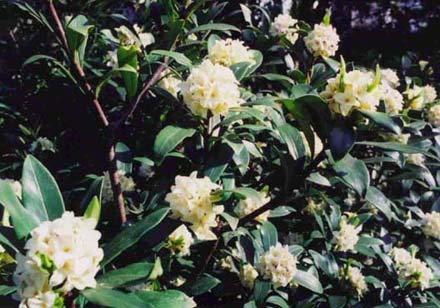
《
Homepage Contents 》
(1) What was the Movement for Civic Rights and Freedom ?
(2) CHRONOLOGY
(3) “ THE POLITICAL CONDITION OF JAPAN ”
BY TATUI BABA , PUBLISHED 1888.
(4) Reference Book
(5) Guide to Exhibition Room
(6) Statistics
|
What is the Movement for Civic Rights and Freedom ?
|
◎自由民権運動って、何ですか?
|
|
It was a political and cultural movement, widespread in Japan in the first
half of the Meiji Era, the aims of which were to establish civic rights
and freedom, to challenge the government controlled by ancient feudal sects,
and to encourage the people's involvement in politics.
|
◎人民の権利や自由の拡大を目標に掲げ、藩閥政府に対抗し、政治に参加しようとした、明治前半期の広範な政治的文化的運動。
|
|
It began in 1874 (Meiji 7), at approximately the time when Taisuke Itagaki
and others presented their recommendation for an elected national assembly.
At first the warrior (samurai) class and the urban intellectuals were the
principal members of the movement, but gradually wealthy farmers from rural
areas joined in, to make it a nation- wide movement. As a result, in 1881
(Meiji14), the government was forced to make a proclamation for the future
establishment of the Diet, or national assembly.
|
◎1874(明治7)年、板垣退助等による民撰議院設立建白書提出前後の頃に始まる。最初は士族や都市知識人中心の運動であった。次第に地方の豪農層も加わり全国的なものとなった。1881(明治14)年には、政府に国会開設の詔勅を出させた。
|
|
After 1883 (Meiji 16), some radical members of the movement staged revolts,
but they were suppressed. Over time, the movement had created the political
momentum for three kinds of reform : freedom of opinion, reduction in land
tax, and improvements of treaties in 1887 (Meiji 20), and Daido Danketu
(the clothing of ranks) Undo. This in turn led to the establishment of
the Min-To, the party for ordinary people, in the early stages of the Diet.
|
◎1883(明治16)年以降、急進派が激化事件を起こしたが鎮圧された。1887(明治20)年の三大事件建白運動や、大同団結運動をへて、初期議会の民党につながる。
|
|
Bibliography : Kojien, Iwanami Shoten, CD-Rom edition,1999.
|
※参考文献『広辞苑・第五版』CD-ROM(岩波書店)
|
|
THE
MODERN WORLD-SYSTEM
|
近代世界システム論
|
|
What was the British Revolution ?
Was not the great social change in England in 1660 the
agreement among the dominant strata that there was to be no
more internal social change, that the English state was to
concentrate on promoting economic development at the expense
of the rest of the world-economy? And did not the Glorious
Revolution of 1688-1689 confirm this?
(THE MODERN WORLD-SYSTEM・ The Second Era of Great
Expansion of the Capitalist World-Economy,1600-1750 by
Immanuel Wallerstein Copyright 1980 by Academic Press,
Inc.)
|
イギリス革命とは何か?
一六六○年のイギリスにおける大きな社会変化とは、支配階層のあいだで、これ以上の国内の社会変化は押し止めようという合意が成立した、ということではなかったか。さらにいえば、それは、イギリス国家は同じ「世界経済」に属する他の地域の犠牲において、経済発展をはかることに集中しようという意味の合意でもあったのではないか。じじつ、一六八八年から一六八九年にかけての名誉革命はこの合意を確認したといえるのではないか。
(I・ウォーラーステイン著、川北稔訳『近代世界システム
1600〜1750重商主義と「ヨーロッパ世界経済」の凝集』133頁、名古屋大学出版会,1993年)
|
|
What
was the French Revolution ?
First, it was a relatively conscious attempt by a diverse
group of the ruling capitalist strata to force through
urgently needed reforms of the French state in light of the
perceived British leap forward to hegemonic status in the
world-economy.
(THE MODERN WORLD-SYSTEM・ The Second Era of Great
Expansion of the Capitalist World-Economy,1730-1840s
by Immanuel Wallerstein Copyright 1989 by Academic Press,
Inc.)
|
フランス革命とは何か?
第一に、それは、早急にフランス国家の改革を強行しようという、支配的な資本家層のなかの一集団による、かなり意識的な試みであった。このような改革は、「世界経済」におけるヘゲモニー国家の地位をめぐる争いで、イギリスが先んじていると感じられたために、必要になったものであった。
(I・ウォーラーステイン著、川北稔訳『近代世界システム1730〜1840S大西洋革命の時代』107頁、名古屋大学出版会、1997年)
|
|
ON LIBERTY, CHAPTER ・, Of Individuality, as One of the
Elements of Well-Being
|
中村正直訳『自由之理』卷之三
|
|
Human nature is not a machine to be built after a model, and
set to do exactly the work prescribed for it,but a tree,
which requires to grow and develop itself on all sides,
according to the tendency of the inward forces which make it
a living thing.
|
人ノ性ハ一模型ニ随ッテ造レル一機関ノ如キモノニアラズ。前定ノ規矩ヲ死守シ、運動作用ヲ為スモノニアラズ。樹木ト雖ドモ、自己ニ具フル活底ノ勢力ヲ発出シ、四方ニ舒展シ、自由ニ暢茂生長セリ。人ニシテ樹木ニ如ザルベケンヤ。
|
【 CHRONOLOGY
】
1874 〜1890
1874(Meiji
7)
Itagaki Taisuke and followers organize political party, the
Aikoku-koutou.
Itagaki Taisuke and others present a written petition favoring the
establishment of a house of elected representatives.
1875(Meiji 8)
Osaka Conference : establishment of a representative assembly
discussed.
1876(Meiji 9)
Japan-Korea Amity treaty concluded.
Uprising in Ibaraki and Mie prefecture by peasants who demand a land
t ax reduction; lower rates implemented in 1877.
1877(Meiji 10)
Satuma Rebellion ; Saigo Takamori commits suicide.
1878(Meiji 11)
Home Minister Okubo Toshimichi assassinated .
1880(Meiji 13)
Aikoku-sha renamed Kokkai-kisei-doumei ( union for establishing a
national assembly ).
1881(Meiji 14)
Itagaki Taisuke organizes Liberal Party ( Jiyuu-tou ).
1882(Meiji 15)
Okuma Shigenobu organizes Institutional-Progressive Party (
Rikken-kaishin-tou )
Hukushima Incident
1884(Meiji 17)
Kabasan Incident : radical members of Liberal Party rose up in
Mt.Kaba ( Ibaragi prefecture ) to over-throw despotic government
.
Liberal Party dissolved.
Chichibu Incident : peasants in the Chichibu region of Saitama
Prefecture, led by members of the Freedom and People's Rights
Movement, rose against the government.
1885 (Meiji 18)
Osaka Incident
1887(Meiji 20)
SANDAI JIKEN KEMPAKU MOVEMENT ( movement to memorialize three
important item ) proposes revision of the Unequal Treaties with the
Western powers and Tax Reduction and Freedom of Speech.
1889(Meiji 22)
Constitution of the Empire of Japan promulgated.
1890(Meiji 23)
First session of the Imperial Diet convened.
【Reference Book】
“ JAPAN An Illustrated Encyclopedia ” ― Published by Kodansha
1993
“
THE
POLITICAL CONDITION OF JAPAN
:
SHOWING THE DESPOTISM AND INCOMPETENCY OF THE CABINET
AND THE AIMS OF THE POPULAR PARTIES ”
BY TATUI BABA , PUBLISHED
1888
.
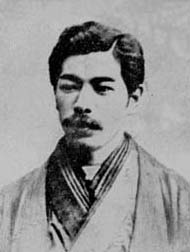
TATUI
BABA
★The civil
war for the restoration of the Mikado to his legitimate throne ended
in 1870, and each Daimio received his reward in elevation of rank and
increase of income. But those who accomplished the work of
restoration were compelled to recognize necessity of abolishing the
feudal system. This abolishing was peacefully achieved, but those who
brought it about acted from very different motives , and perhaps did
not quite foresee the practical results. The members of the Cabinet
became divided. Several minor differences existed among the
officials, but the main difficulty was that one party desired to
enter upon fresh work while another sought to finish what had beed
already begun, without undertaking anything further. The enterprising
and more adventurous party was represented by Saigo, one of the
greatest warriors Japan has ever produced, and the opposite party by
Okubo.
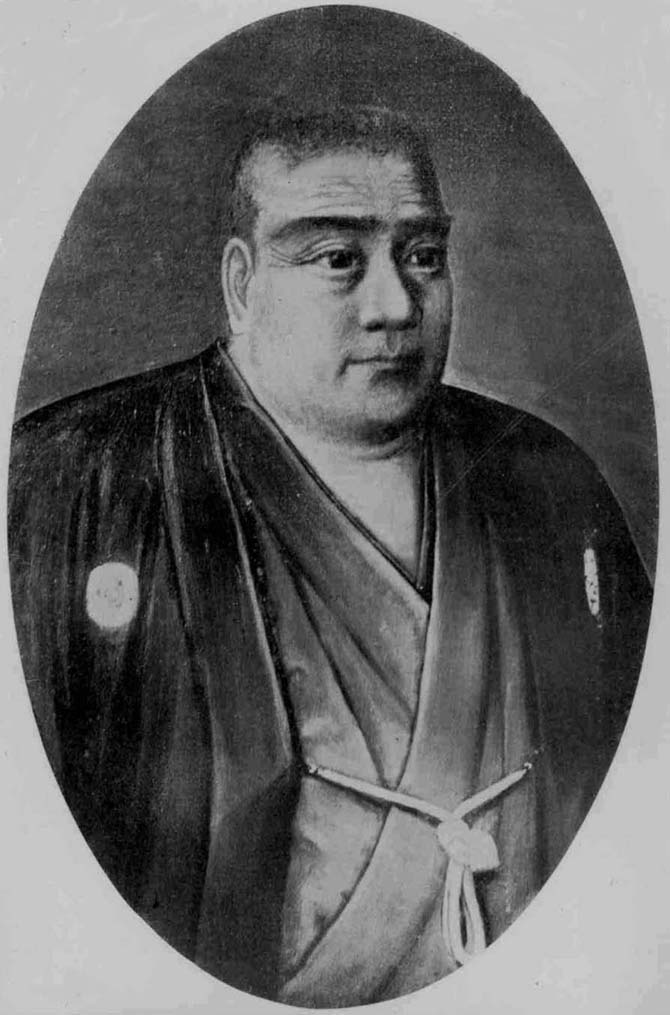
Takamori
Saigo
★Again and
again the government army was defeated, but at last Saigo's
ammunition was exhausted ; he fought his last battle in Siroyama, in
his native province, and died on the field. This was in the tenth
year of Meiji or A.D. 1877. Okubo had now undisputed power in the
government of Japan, but he did not enjoy his supreme position much
longer. In 1878 he was assasinated by Simada Ichiro in Tokio. This
threw the Japanese Cabinet in a state of chaos. While Okubo lived, he
had unlimited sway over his colleagues; that is there was a wide gulf
between him and other Ministers both in personal authority and in
strength of will. All the other Ministers were mere secretaries, or
they might be better described as servants of his will. Now this
absolute and central head was suddenly cut off. There was no leader
who could give united action to the schemes of the government. This
weak government was carried on by conferences and negotiations
between different Ministers.
★ Meanwhile the popular movement was going on side by side with the
political change in the government. About the year 1874, several
newspapers sprang up and began to discuss political and social
questions in Japan. Students returned from Europe and America and
began to form societies . I may mention one society in particular
which gave many social and scientific benefits to Japan, until
reduced to nothing throgh government interference. It was called
Kioson Doshu, or “the society for social intercourse. ” It was
originally formed by some Japanese who were studying in London in
1873. Some of the members of this society, having returnd to Japan in
1874, f ormed a society similar to that which was established in
London . They used to meet monthly to discuss the subjects of
political and social reform in Japan. In 1878, this social or popular
movement became more active.
★The newspapers were the first to meet with a check. Press laws and
newspaper regulations were made and writers were imprisoned for a
year or eventhree years for very slight offenses. The government,
issued other regulations about public meetings in
1880. ・・・・・
The first clause of these regulations says that those who hold any
public meeting concerning politics, must obtain permission from the
police station of the district, after placing in the office outlines
of the speeches, names of the speakers, and the officers and date of
the meeting. ・・・・・
Ninth. - Open air meetings shall not be permitted. All offenders
are punished with fines varying from two dollars to one hundred
dollars, and imprisonment with hard labor from two mouths to two
years. The speaker whose speech is declared by the police to be
injurious to the peace of the country is forbidden to make any speech
from six months to a year.
★ In spite of these difficulties and obstacles the Japanese people
continued organizing themselves with the object of propagating
liberal ideas. Political speeches were delivered in all parts of
Japan. I myself went to the northeastern provinces, such as Shinshu,
Yamagata, Yechigo, and others. People began to attend the meetings in
thousand, and I often spoke in meetings consisiting of two or three
thousand people. Every sign of the powerful popular movement was
shown in these meetings.
At last the liberal party was formed in Tokio in 1881. Two
principal papers became its organs, and very important questions were
brought forward. The present Cabinet, seeing the pressure of popular
influence, advised the Mikado to make a promise to establish a
representative assembly in 1890.
★ About this time many deputations were sent to Tokio from all parts
of Japan. Their object was twofold. First to ask the Cabinet to
explain its foreighn policy; and second, to petitiion the government
to relieve the poor farmers from oppression of a heavy overtaxation.
But the Cabinet issued one of its despotic edicts on December 27th,
1887, and expelled all the members of the deputations from Tokio.
Thousands of the policemen marched to all parts of the capital, where
the members of deputations were living, and expelled more than four
hundred people in one day.
★ What we demand of the present government (in 1888) is simply this
:-
First the establishment of a National Assembly, making the present
government a constitutional monarchy with responsible ministries.
Secondly, the abolition of the censorship of the press and the
regulation of the newspapers.
Thirdly, the abolition of the regulations for holding public
meetings.
Forthly, the revision of the treaty between Japan and Europe.
Already the government is tottering under the influence of the
voice of the people. Its days are numbered, and it will be overthrown
by the popular party. A new Cabinet will be formed instead of the
present despotic government.
《 Leading
Democratists Born In Kochi City 》
★Taisuke
Itagaki : Founder of Japan's First Political Party
1837-1919
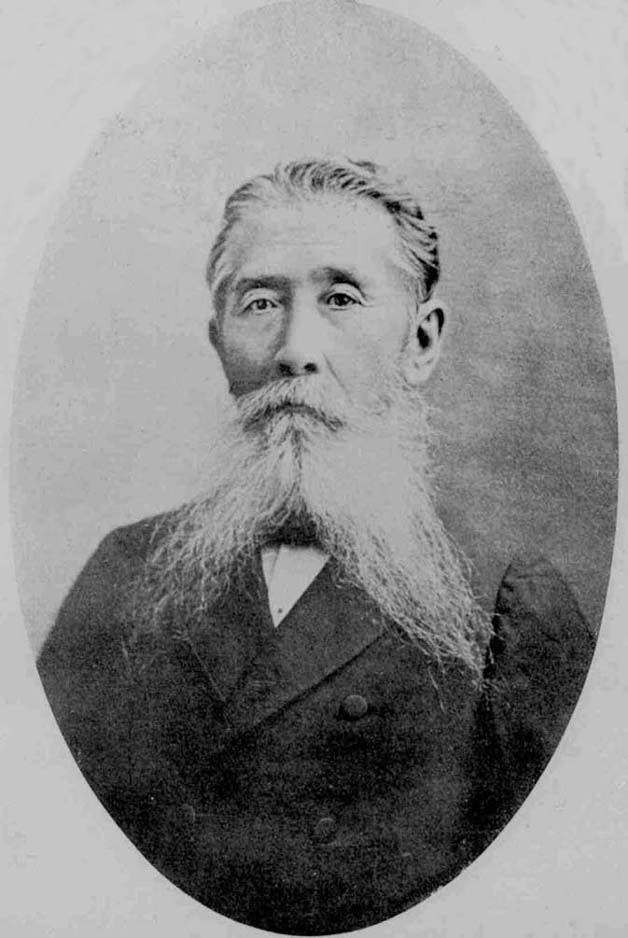
A
politician born in 1837 at the foot of Kochi Castle. After
participating in the Boshin Civil War (the series of battles between
the pro-imperialist and the shogunate forces which culminated in the
Meiji Restoration), he became a powerful politician under the new
government. He was involved in key reforms of the time, but resigned
in protest in 1873 over what he saw as the government's dictatorial
mishandling of a crisis with Korea. He returned to Kochi and, in
1874, established Risshi-sha, a political organization born from the
blending of Western democratic ideals with the best traditions of the
samurai , and concerned with issues of freedom and people's rights.
In 1881, he and others organized Japan's first true political party
(the Jiyu-to or "Liberal Party"), of which he became the became the
Governor. This movement grew to nation wide status. With the
promulgation of the constitution in 1889, he led the establishment of
the national assembly.
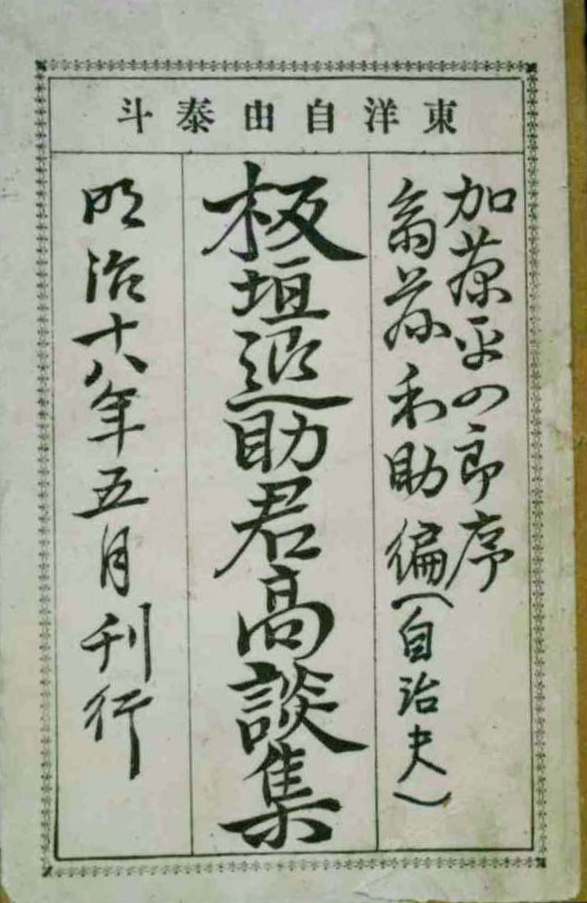
★Chomin
Nakae : Philosopher, Political Theorist, Civil Rights Activist
1847 - 1901
One of the leading liberal political thinkers of the Meiji
period. Born at the foot of Kochi Castle in 1847, he left Kochi at
the age of 19 to study French in Nagasaki Prefecture. At the age of
25, he traveled to France where he was much influenced by Rousseau.
After returning to Japan, he established 'France Gakusha' (or
institute). He was a leader of the radical wing of the Freedom and
People's Rights Movement. He was an influential civil-rights activist
and prolific writer until his death from cancer at the age of
55.
★Emori
Ueki : Political Theorist, Politician
1857 - 1892
A democratist born in Kochi City in 1857. In 1877, when he was
21, he became a member of Risshi-sha, the political organization
founded by Itagaki. He asserted that people had naturally endowed
human rights and published his ideas in a popular pamphlet in 1879.
In 1881, he wrote a draft constitution which was not published.
However, his ideas were influential in the drafting of the new
constitution after World War II. In 1890, he won a seat to Diet in
Japan's first national election, but died suddenly 2 years later at
the age of 35.
【Reference
Book】
“ The Movement
for Civic Rights and Freedom in the 1880s of BOSO District
: I think while I am walking and continue walking while I think
”
by KOJI SAKUMA, published 1992 by Ron Shobou.

“ The
Movement for Civic Rights and Freedom at the Bottom Point.”
by KOJI SAKUMA, published 2002 by Iwata Shoin.
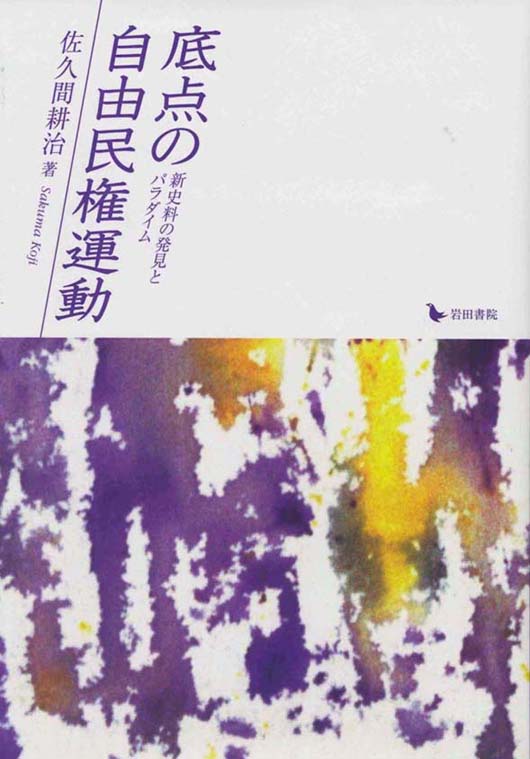
【 Guide to
Exhibition Room 】
Under
the rising sun,
The light will shine again.
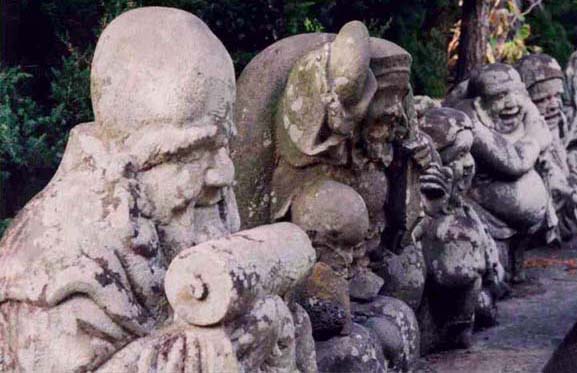
【STATISTICS】
Position
of the Movement for Civic Rights
and Freedom in the 1880s
of chiba prefecture in the whole country
【 Number of
Petitions and
Recommendaitions,1874〜1884】(
Best 10 )
|
Ranking
|
Prefecture
|
Petitions
and
Recommendaitions
|
|
1
|
kouchi
|
48,392
|
|
2
|
chiba
|
32,015
|
|
3
|
hirosima
|
26,394
|
|
4
|
okayama
|
25,204
|
|
5
|
kanagawa
|
23,555
|
|
6
|
nagano
|
23,536
|
|
7
|
sizuoka
|
20,000
|
|
8
|
hukuoka
|
13,358
|
|
9
|
siga
|
12,530
|
|
10
|
ibaragi
|
12,263
|
【Number of
Democratic Parties,1874〜1884】(besto10)
|
Ranking
|
Prefecture
|
Democratic
Parties
|
|
1
|
kouchi
|
127
|
|
2
|
ibaragi
|
99
|
|
3
|
kanagawa
|
97
|
|
4
|
niigata
|
76
|
|
5
|
sizuoka
|
74
|
|
6
|
miyagi
|
62
|
|
7
|
chiba
|
57+α
|
|
8
|
tochigi
|
55
|
|
9
|
hukusima
|
48
|
|
10
|
saitama
|
45
|
【Number of
Members of Liberal Party,1874〜1884】(best10)
|
Ranking
|
prefecture
|
Members
of Liberal Party
|
|
1
|
akita
|
428
|
|
2
|
tochigi
|
315
|
|
3
|
kanagawa
|
268
|
|
4
|
gunma
|
212
|
|
5
|
chiba
|
183
|
|
6
|
nagano
|
178
|
|
7
|
saitama
|
148
|
|
8
|
simane
|
121
|
|
9
|
ibaragi
|
112
|
|
10
|
tokyo
|
82
|
Flags of
Uprising and Democracy
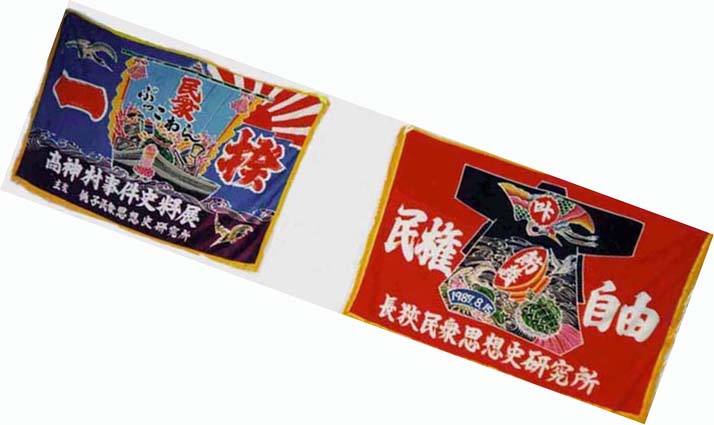
We are waiting for your acces again.
e-mail:sakumako1@athena.ocn.ne.jp click
address: KOJI SAKUMA 723 Minamikomachi Kamogawa
City Chiba Prefecture
〒296-0104 JAPAN
***** back
to top
*****









